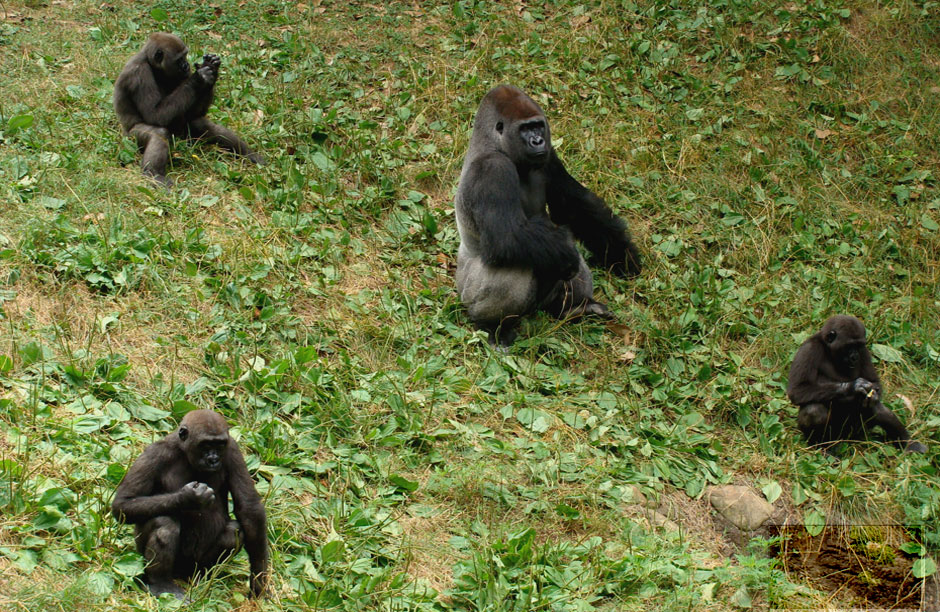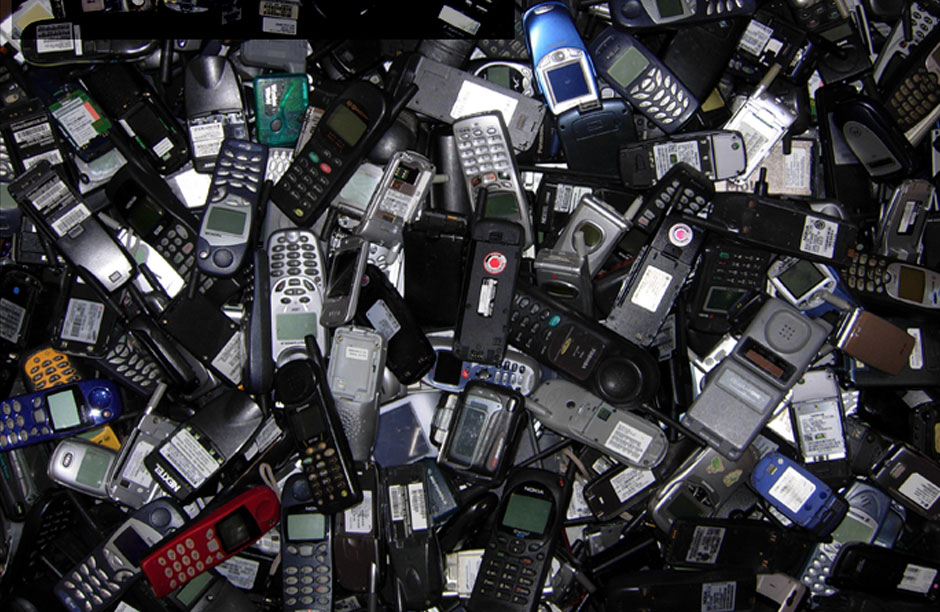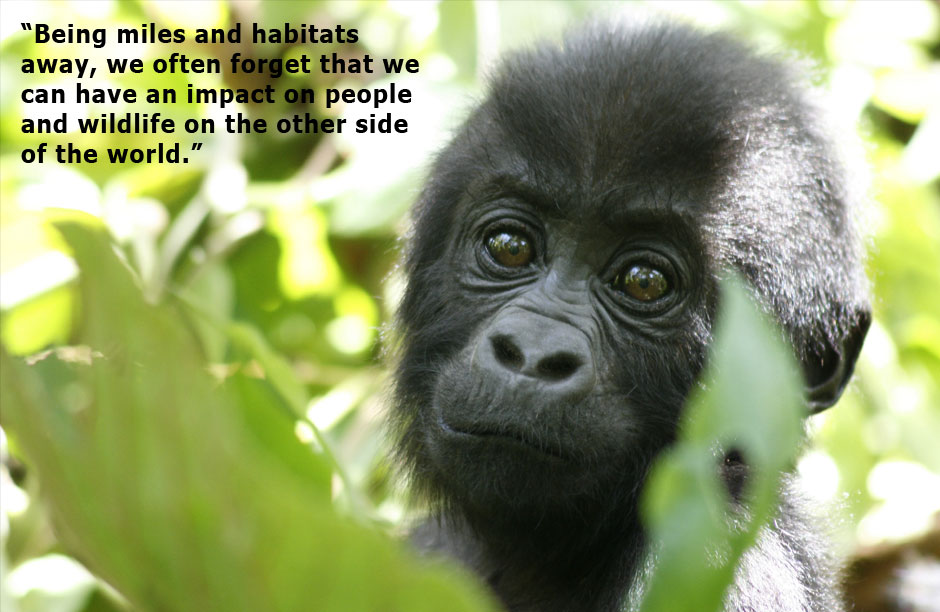PAST ISSUES
 Top Left (clockwise): Kazi, Taz, Kali and Gunther hanging out at Zoo Atlanta.
Top Left (clockwise): Kazi, Taz, Kali and Gunther hanging out at Zoo Atlanta. "When a cell phone rings the last thing you would think of is gorillas": Discarded cell phones pile up at the Eco-Cell office in Louisville, Kentucky.
"When a cell phone rings the last thing you would think of is gorillas": Discarded cell phones pile up at the Eco-Cell office in Louisville, Kentucky.
I Helped Save a Gorilla Today
By Sumir KeenanI am sitting in my office at Zoo Atlanta entering the data I collected earlier into a massive spreadsheet. At 1:37 pm Taz was sleeping, Kuchi was nursing her five-week-old baby, Kudzu was eating a zucchini, Sukari was playing with Macy and Kazi, and Gunther and Kali were intently examining something in the grass. At 1:42 Taz was still sleeping, Kuchi still nursing, Kudzu had long finished her zucchini, Sukari was now eating and Macy and Kazi had gone over to check out what Gunther and Kali had found. At Zoo Atlanta we are part of a multi-institutional study that collects thousands of hours of data on the gorillas at zoos and animal parks around the country. All of this information is a valuable resource to primatologists that are seeking to answer questions about gorilla behavior, social structure and even cognition. My phone rings as Jodi, the gorilla zookeeper, enters the room, I ignore the call and take the heavy box she is handing me. The box reads “I Helped Save a Gorilla Today!” and is full of old cell phones.
Gorillas are one of the four species of great ape and are further divided into four subspecies. The western lowland and cross river gorillas are found in the western African countries of Nigeria, Cameroon, Central African Republic (CAR), Equatorial Guinea, Gabon, Republic of Congo, Angola, and far-western Democratic Republic of Congo (DRC). Grauer’s gorillas (also known as eastern lowland gorillas) and mountain gorillas are found along the same latitudes in the central part of Africa in eastern DRC, Rwanda and Uganda. All four subspecies are either endangered or critically endangered, with all but the mountain gorilla’s numbers still declining. The Grauer’s gorilla, found only in the DRC, are particularly vulnerable.
Despite being rich in natural resources, years of extreme mismanagement, corruption and war have left The Democratic Republic of Congo as the poorest country in the world (as listed by the International Monetary Fund and the World Bank). The eastern region of the country, home to the Grauer’s gorilla, is particularly unstable. The area was the central stage for what has become known as the Great War of Africa, a war that left between 4-5 million dead from disease, starvation and fighting and many millions more displaced. Even though the war officially ended in 2003, a number of Congolese and foreign militia groups still hold primary control of the region. (Since early 2009 extensive peace negotiations have been ongoing, and 2010 has seen some notable successes.) The Kahuzi-Biega National Park (and surrounding forests) is home to the largest Grauer’s gorilla population. The park’s extensive forests, rich in flora, fauna and mineral deposits also make it appealing for militia, poachers, peasant farmers and most recently miners.
The 2001 United Nations Security Report said that the war and unrest in eastern Congo had become “mainly about access, control and trade” of minerals, primarily coltan. Coltan (columbite – tantalite) is an ore from which the mineral tantalum can be extracted. Tantalum is a highly conductive, heat resistant mineral used in almost all major electronics; from cell-phones to pacemakers to jet-engines. Since the beginning of the war in 1997 and an influx of an estimated 12,000 individual miners; the Park, once listed as the second most biologically diverse site in Africa, has seen a devastating reduction in population numbers of many species. Although exact numbers are unclear, experts estimate that of the 12,000 – 15,000 gorillas that inhabited the park in the late 1990’s only 2,000 – 5,000 remain.
By the end of the week my desk is surrounded by three large boxes full of cell phones bound to Eco-Cell for recycling. Eco-Cell is a non-for-profit company established in 2002 to help combat the affect coltan mining is having on the people and wildlife of eastern DRC. “Local warlords responsible for civil unrest and even genocide, are paying Congolese miners, including young children, next to nothing to work in hazardous, unsanitary conditions to reap Coltan. The people of Congo would be better served by showcasing their country’s incredible biodiversity in the form of ECO-Tourism and the job opportunities formed via a stable government and business environment”, says Eric Ronay, the owner of Eco-Cell. So here is how it works; over 115 North American zoo’s and various other institutions collect old cell-phones, send them to Eco-Cell who recycle them and then send 90% of the profit back to the institution, who then donate the money to various charities and organizations working in the DRC. The Dian Fossey Gorilla Fund International is just such an organization.
“The Fossey Fund works on the ground to protect the populations of Grauer’s gorillas affected by mining for minerals like coltan. These gorillas have also suffered from habitat loss and the years of civil unrest in eastern DRC. The Fossey Fund works with the local community to protect the endangered Grauer’s gorillas and other species that share its habitat by developing community reserves that will create a large mammal corridor between two national parks. We also help communities living near the gorillas to develop new sources of income, health care, food and clean water and to understand the significance of conserving biodiversity. These activities help create community support that is essential to successful conservation efforts”, says Dr. Tara Stoinski, McGrath Chair of Research and Conservation Dian Fossey Gorilla Fund International.
Being miles and habitats away we often forget that we can have an impact on people and wildlife on the other side of the world. When a cell phone rings the last thing people would think of is gorillas. It’s just another example of how John Muir was so right when he said “When we try to pick out anything by itself, we find it hitched to everything else in the universe.”